Sweet apple tree Medunitsa
The apple tree Medunitsa is a summer variety bred in the USSR in the 30s. It still has not been included in the register, because no one can determine its exact yield. The fruits are so delicious that they are eaten before they are fully ripe. The variety is well suited for growing in temperate climates and northern latitudes.
- Variety characteristic
- Description of the tree and fruit
- Yield
- Taste
- Pollinating varieties
- Winter hardiness
- Disease and pest resistance
- Fruit application
- Types of rootstocks and varieties
- Seed stock
- Semi-dwarf rootstock
- Dwarf and columnar stock
- Winter lungwort
- Planting varieties
- Landing dates
- Pick-up location
- Selection and preparation of seedlings
- Landing technology
- Care rules
- Watering
- Top dressing
- Pruning
- Pest and disease control
- Features of ripening and fruiting
- Harvesting and storage
- Gardeners reviews
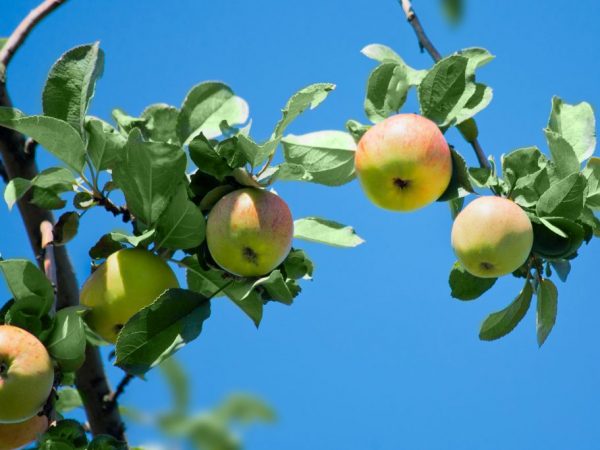
Sweet apple tree Medunitsa
Variety characteristic
The apple tree Medunitsa has a delicate honey aroma, but the name of the variety is not connected with this at all.
Its creator, Professor Isaev, gave her the name with which he tenderly called his wife in his youth. He also associated the name with the spring flower Medunitsa.
The ancestors of the variety were Cinnamon Striped and Welsey. The result is a variety with an unusually sweet taste and high winter hardiness. It was specially bred for growing in cold regions.
Description of the tree and fruit
Description of the apple tree Medunitsa:
- Tree height - 5-7 m
- The crown is pyramidal, with the top at the bottom
- Drooping branches
- Shoot formation rate is average
- Foliage color - light green
The flowers are large, can reach 5 cm in diameter. Petals are white with a slight pink tint.
Description of fruits:
- The apples are medium in size, they weigh 90-150 g.
- Rounded shape, slightly flattened at the poles
- The ribbing is quite clearly visible on the surface.
- Main color - green-yellow, blush in the form of stripes, blurred pattern
- The pulp is creamy or yellowish, fine-grained, juicy
The apple contains almost 14% sugar, very few acids. The amount of vitamin C is 8 mg / 100 g.
The fruit contains about 5 mg / 100 g of chlorogenic acid, which promotes the excretion of oxalic acid. Therefore, they are recommended for gout.
Quercetin in the peel plays the role of an antioxidant, it prevents atherosclerosis, neutralizes the action of free radicals. Pectins contribute to the elimination of heavy metals.
Yield
Lungwort is a fairly productive variety: up to 80 kg of fruit are harvested from the apple tree. More mature trees can produce up to 180 kg of fruit.
Productivity is stable, only after 20 years can there be breaks in fruiting for a year. Such indicators make it possible to grow it on an industrial scale.
Taste
The taste characteristics of apples are quite high.
Due to the high sugar content, the pulp is very sweet, the sourness is practically not felt, but there are clear honey notes. Even unripe green fruits are already sweet.
The pulp is juicy and crispy. The aroma is pronounced, honey notes are felt. Unfortunately, honey taste and smell disappear within two weeks after harvesting.
Pollinating varieties
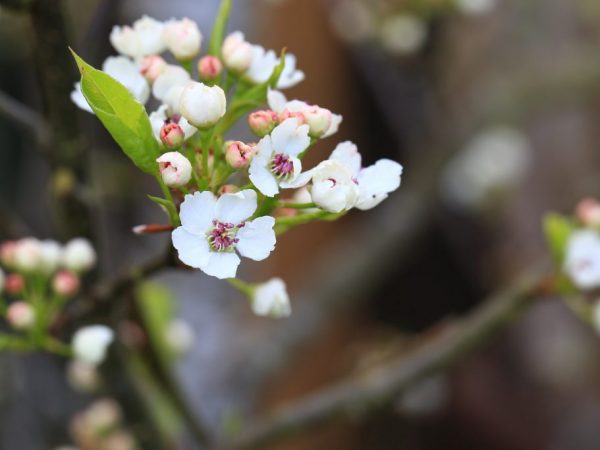
Pollinators will increase yields
According to the description, the variety is considered self-fertile: apple pollen is capable of fertilizing flower pistils on the same tree, but in the presence of pollinators, the yield of Lungwort increases, more ovaries are formed.
When choosing a pollinator, you need to focus on the flowering period. At Medunitsa, it falls in late May and early June. Anis Sverdlovsky, Cinnamon striped, Kerr, Zolotaya, Pobeda have approximately the same terms.
The distance between apple trees should be no more than 50 m. There can be no more than 10-12 trees per pollinator.
Winter hardiness
One of the main tasks in breeding the variety was to develop good frost resistance.
The breeders managed to completely cope with it. Young seedlings are able to withstand a drop in temperatures down to -20⁰С, old ones - up to -30⁰С.
Even after freezing, many branches are able to regenerate. But after a harsh winter, the tree should definitely be examined and dead twigs removed.
Disease and pest resistance
The variety is resistant to scab and fruit rot.
These fungal diseases never affected the tree, even if there were diseased plants nearby.
Fruit application
The apple Lager is unusually sweet, even with incomplete ripeness, has a delicate honey aroma.
The produce can be grown for sale. But it needs to be implemented quickly, because fruits are poorly stored.
Apples make delicious jams and preserves. The fruits are processed into juices and jam.
Types of rootstocks and varieties
A number of characteristics of the future apple tree depend on the rootstock of Medunitsa: the height and width of the crown, the beginning of fruiting and life expectancy.
Depending on the stock, a planting scheme is chosen. There are also varieties of varieties.
Seed stock
The seed stock is the classic type.
The tree grows up to 5-7 m, the first fruits appear in 5-6 years. The crown is wide, pyramidal.
Apple trees live up to 80-90 years, retain high productivity for 50-70 years. They need to be planted at a distance of 4.5-5.5 m from each other. The variety requires regular pruning.
Semi-dwarf rootstock
The height of the apple tree is 4-4.5 m, it begins to yield at 3.5-4.5 years. Lives long enough, although less than the classic one.
An important characteristic of the stock is the ability to grow at a high groundwater table.
You need to plant trees at a distance of 3 m. The semi-dwarf rootstock is considered the best for industrial cultivation.
Dwarf and columnar stock
Small trees on a dwarf rootstock are becoming more and more popular.
The seedling of Medunitsa takes root well in such species: the apple tree reaches from 1.5 to 2.5 m in height, fruiting begins early, the first ovaries appear already in the second year after planting.
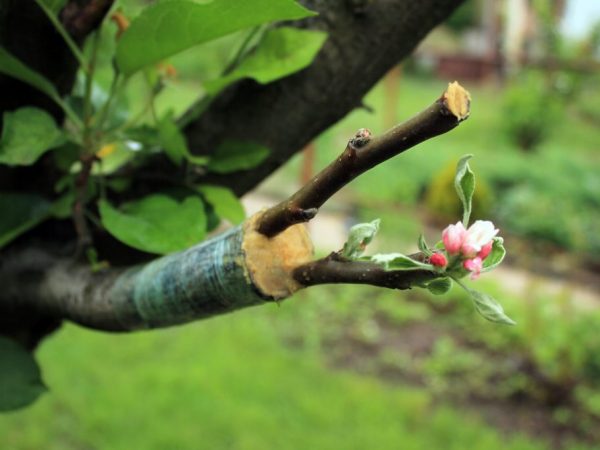
Dwarf rootstock is not durable
The disadvantage is the short life expectancy. After 12 years, productivity drops sharply, and after another year or two, the tree dries up.
According to the recommendations of gardeners, small apple trees must be tied up. They have a weak root system, any stress or strong gusts of wind can damage it.
There is no point in grafting this variety on a columnar stock. The main feature of the stock is a narrow crown with branches growing parallel to the stem. After grafting, branch growth will be disrupted.
Winter lungwort
It differs from summer only in terms of ripening and storage of fruits.
at the Winter Lungwort, they reach their condition at the end of September, they can lie until spring, they have a sweet honey taste and a denser flesh.
Planting varieties
After choosing a variety, be sure to familiarize yourself with the features of its planting. Sometimes a description of the process is attached to the seedlings, but not all nurseries give such instructions.
Landing dates
Planting dates depend on the region and take into account the likelihood of frost, which can damage young plants.
For the Moscow region and the Leningrad region, late spring frosts are more typical, for the Urals and Siberia - early autumn ones. In addition, winters are more severe in the north.
Therefore, in regions with a temperate climate, it is advised to plant apple trees in the fall, 3 weeks before the expected frost. In the north, it is better to do this in spring, so that the winter cold does not destroy the trees. When planting in spring, be sure to wait until the earth melts at a depth of 60-80 cm.
Pick-up location
The Medunitsa variety is unpretentious to the soil: an apple tree can grow on loam, sandy soil. But the more fertile the land, the higher the yield.
When planting, be sure to take into account the level of groundwater. Only the variety on a semi-dwarf rootstock tolerates their high standing well. Other types can die in such conditions.
The place should be protected from wind and draft. It is good if the future apple tree is evenly illuminated by the sun - this way you can achieve greater synchronization in the ripening of fruits.
Selection and preparation of seedlings
It is better to buy seedlings in specialized nurseries, it is better in a tub, then you can see their foliage and you can assess the condition. If there are no such on sale, take with a lump of earth, and not with bare roots.
The bark should be smooth, have a light brown tint, with a medium edge. Particular attention should be paid to the sheets, they should be narrow and elongated, with a slight relief and bend.
When transporting, the roots should be wrapped in foil, hay or moss. Immediately before planting, the root system can be gently freed from the soil.
Landing technology
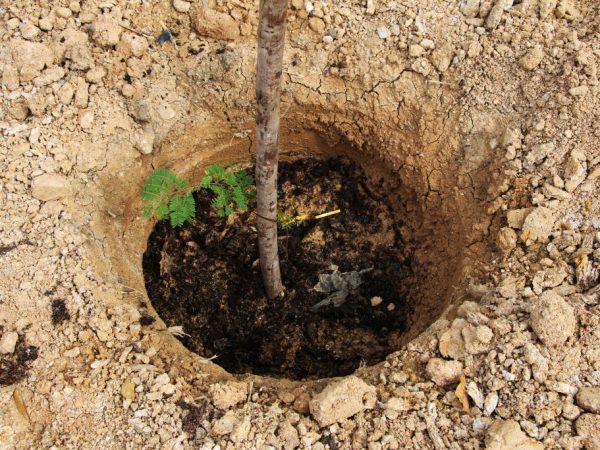
The pit must be prepared in advance
For autumn planting, the pit is prepared in 4-5 weeks, for spring planting - even in the fall.
Its dimensions should be approximately 50 × 50 × 50 cm (for three-year-old seedlings, 10-15 cm more). A layer of drainage is laid at the bottom of the pit, 15-20 cm thick. Small pebbles, crushed stone or expanded clay are suitable.
Fertile soil, which was pulled out of the pit, is mixed with complex mineral fertilizer and compost. Then they again fall asleep in the pit. In this state, the place is left for several weeks (or for the winter).
Before planting, a peg is driven into the hole. Then a seedling is placed in the center, after having straightened its roots. Sprinkle with earth so that the root collar rises above the mound by 3-4 cm.At the end, pour 2-3 buckets of water.
Care rules
Apple trees Medunitsa requires standard care, which includes:
- Watering
- Fertilization
- Pruning
- Prevention of diseases and tree damage by pests
Watering
It is not worth watering the apple tree too much. In dry weather, it is enough to pour 4-5 buckets of water under a mature tree twice a month.
If the summer is rainy, one-time watering is carried out every 30-40 days.
Young seedlings need more intensive watering. They need to be watered once a week with 1-2 buckets of water.
Top dressing
Fertilizers begin to be applied to the soil in the second year after planting. Top dressing is done twice a season.
In the spring, before flowering, nitrogen is added. You can use organic fertilizers (mullein diluted with water 1:10 or 1:30 droppings). Humus or rotted manure is also suitable. You can feed Lungwort with urea.
In the fall, the apple tree needs potassium, phosphorus and calcium. These elements increase frost resistance and help to survive the winter time safely. 90-100 g of superphosphate and 35 g of potassium chloride are introduced under the roots. You can replace them with the usual complex fertilizing for fruit crops.
Pruning
The apple variety Medunitsa needs regular pruning - this is the basic rule of care. The crown begins to form from the second year after planting.
It is best to create several tiers of branches, the distance between which will be 30-40 cm. The bowl option is also suitable, when the upper branches are cut and provide growth due to 4-5 lateral shoots. Then the tree will not be too tall, which will make it easier to pick the fruit.
Every spring, sanitary pruning is carried out, diseased and damaged branches are removed. At the same time, the crown is thinned out. In the summer, you can pinch and remove shoots that shade the fruit.
After each procedure, the "wounds" are covered with garden varnish.Spring work begins before the buds begin to swell and the tree sap begins to circulate.
Pest and disease control
The lungwort is relatively rarely affected by fungi. But for prevention, it is advised to spray it in spring with copper sulfate or Bordeaux liquid.
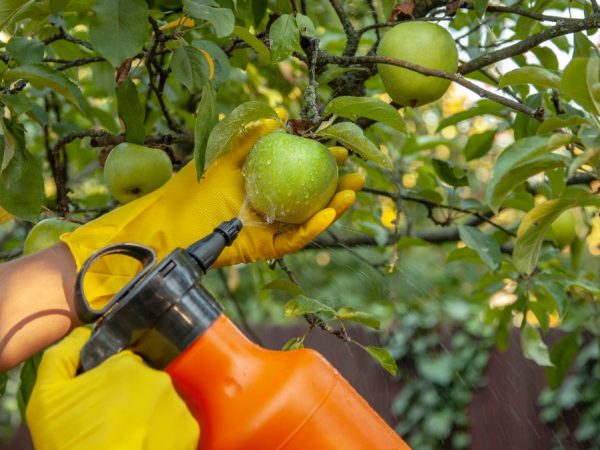
Spraying will get rid of pests
Urea well prevents diseases. It is used to process branches during the formation of ovaries.
At the first symptoms of fungal pathologies, it is advised to use fungicides.
Insecticides are used to control insect pests. You can also spray the tree with soapy water, infusion of dill, garlic or tobacco. For prophylaxis in the spring, it is worth whitewashing a tree trunk with lime.
In the fall, all the leaves are removed from the garden, the earth is dug up. If the trees were sick in the summer, remove all damaged branches. The soil is treated with antifungal drugs and insecticides.
Features of ripening and fruiting
According to the description of the variety, the beginning of the fruiting of Medunitsa depends on the rootstock: on the seed it is 5-6 years after planting the apple tree, on the semi-dwarf - 3-4 years, on the dwarf - 2-3 years.
The highest productivity is at the age of 8-12 years. After that, dwarf species suddenly lose their ability to produce crops. Tall types can bear fruit up to 50-70 years.
Summer Medunitsa begins to ripen in mid-August, and winter - in late September or early October. Apples take on a yellow-green hue, then red stripes appear on their surface. Over time, they become less clear and blurry. If the fruit is facing the sun, it may turn completely red. In a shaded area, even ripe apples remain yellow and slightly striped.
One of the features of maturation is unevenness. Some fruits are ready for consumption in the first decade of August, others - only in the beginning of September. This is due to the great dependence of the ripening of the variety on lighting and sunlight.
If apples grow in the shade, covered with leaves, they take longer to reach condition.
Harvesting and storage
Harvesting begins in the period of technical ripeness: the Summer Lungwort ripens by mid-August, and the winter apple tree - in the last decade of September. At this time, the apples are green-yellow with rare red stripes on the sides.
If you collect technically ripe fruits, they will last longer. For the summer variety, this period can be extended to 2.5 months. Winter can last until mid-March.
To keep the fruits well, they are plucked together with the stalks, each is wrapped in thin paper and put in boxes. Then they are placed in a cool place, the temperature should not exceed 5⁰С.
With a plentiful harvest, it is better to process some of the fruits. First of all, this concerns the summer Medunitsa.
Gardeners reviews
The varieties of apple trees Medunitsa are popular with gardeners. Everyone notes the original taste of apples, there is no sourness in them. The subtle honey aroma is also praised. Unfortunately, it quickly disappears during storage.
All reviews speak of the high yield of the variety. Already for 7-8 years from one tree, you can collect almost a centner of fruits. Young apple trees bear fruit regularly, only after too abundant harvests they can be interrupted for a year.
On older trees, it is recommended to regulate the number of ovaries so that they bear fruit annually.
According to reviews, shelf life is short. But this is not the biggest drawback. After all, apples are so tasty that a family eats them in a couple of weeks. Many say that there is not even left for processing. The tree practically does not require treatment against diseases and pests. You can safely do with harmless folk remedies.

